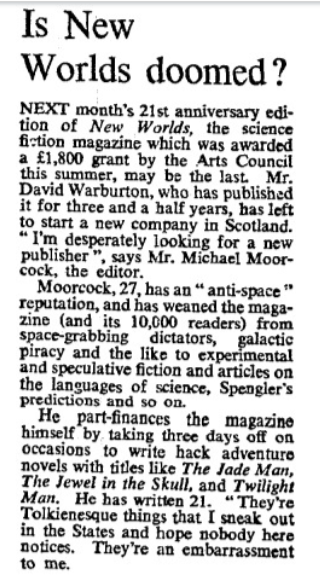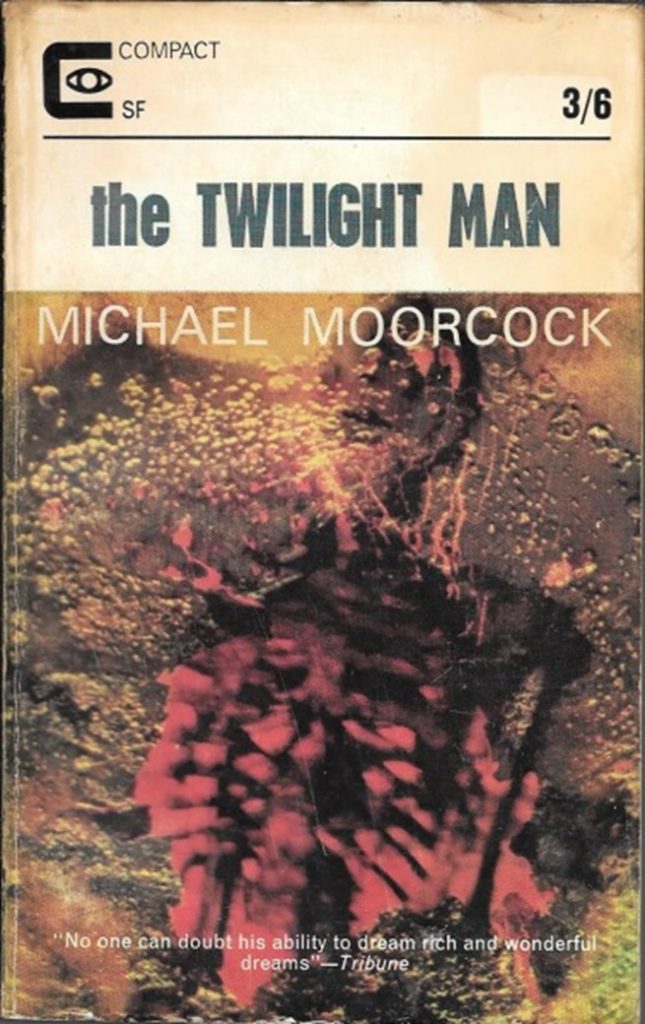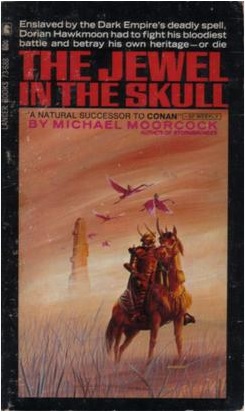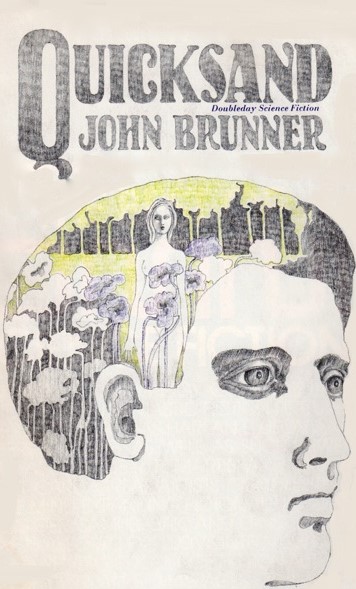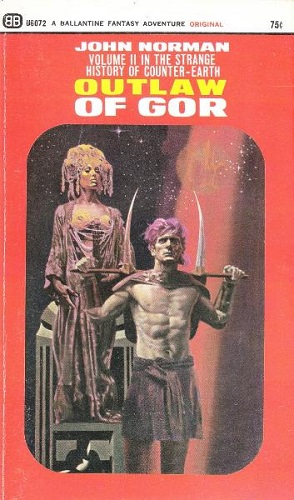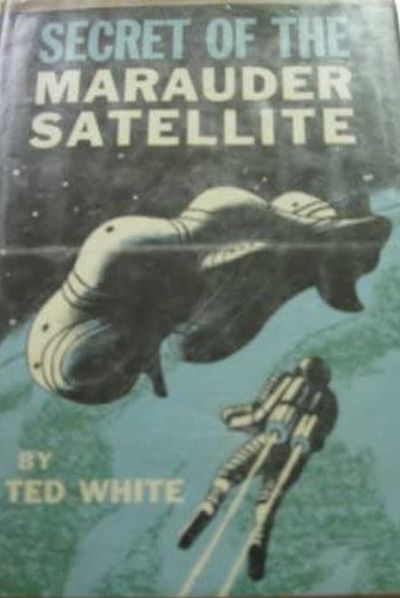
by Victoria Silverwolf
Stranger in a Strange Time
I was greatly impressed by Robert Silverberg's recent novel Thorns. It seemed to mark a new direction for a prolific author of competent, if undistinguished, science fiction. Will his new book reach the same level of quality? Let's find out.
The Masks of Time, by Robert Silverberg

Cover art by Robert Foster.
Christmas Day, 1998. A naked man appears out of nowhere, floating down from the sky. This fellow calls himself Vornan-19, and he claims to come from the year 2999.
With the year 2000 approaching, members of a worldwide apocalyptic cult fill the streets with wild orgies of sex and destruction. As you'd expect, the arrival of Vornan-19 changes things. Is he a fraud? A sign of the impending end of the world? Or proof that Earth will survive for many years to come?
Let's slow down a bit, in the same way the novel does at this point, and introduce some important characters.
The narrator is Leo, a physicist. He's working on time reversal. So far, all he's been able to do is transform a particle into an antiparticle, sending it backwards in time, but also causing it to be instantly destroyed. He's convinced that honest-to-gosh time travel is impossible, and therefore he thinks Vornan-19 is a phony.
Jack is a brilliant graduate student. He's been working on the theory of obtaining all energy from an atom (without the pesky side effect of a nuclear explosion), but he's not interested in any practical applications. For unclear reasons, he drops out and goes to live with his stunningly beautiful wife Shirley in a remote part of the Arizona desert.
The United States government sends Leo and a few other scientists to act as tour guides for Vornan-19, of a sort. They really want these geniuses to figure out if he's truly from the future. (Even if he isn't, he could be useful in convincing the cultists that the world isn't going to end in the year 2000.)
What follows is an episodic account of Vornan-19's encounters with people of the twentieth century. He causes chaos at a billionaire's party, in a mansion that keeps changing shape. He seduces men and women. Vornan-19 remains a mystery, revealing very little about himself or the world one thousand years from now. He becomes an object of religious devotion, leading to the book's dramatic but enigmatic conclusion.
After the intensity of Thorns, this is a surprisingly leisurely book. (I believe it is also the author's longest novel, at about two hundred and fifty pages.) We spend a lot of time with Leo, Jack, and Shirley before the narrator goes off with Vornan-19.
There's also quite a bit of sex. Jack and Shirley are nudists, and pretty soon Leo joins in. The group of scientists following Vornan-19 around includes both women and men, and we get to learn who's sleeping with whom, and who wants to sleep with whom, and who isn't sleeping with whom. Leo spends time with two prostitutes, one supplied by a grateful U.S. government, the other working at a legal, automated brothel.
(I've heard that Silverberg writes a lot of so-called adult novels under various pseudonyms, so maybe he's gotten into the habit of including this sort of thing.)
There's even a sex scene that serves as the book's climax. (Sorry, I couldn't resist the obvious pun.) We also find out why Jack ended his research, and what that has to do with Vornan-19.
This is an elegantly written novel that held my attention throughout. As I've indicated, it's hardly a thriller; the reader needs to be patient to fully appreciate it. There's a touch of satire and some interesting speculation about the technology of the near future.
Four stars.

by Mx. Kris Vyas-Myall
The Programmed Man by Jeff and Jean Sutton
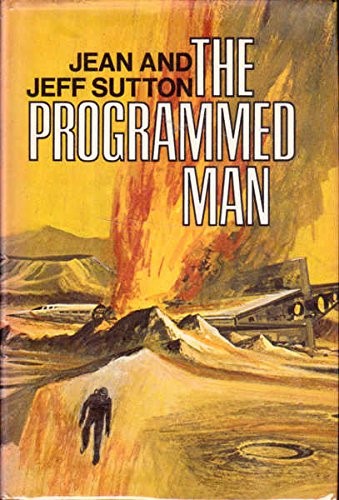
I sometimes like to read books by authors I know nothing about, in the hope of getting a nice surprise. Well, this one certainly is not nice!
What is there to like about this?
The plot? No, dull plodding sub-Reynolds spy nonsense.
The characters? Paper-thin, laden with racist stereotypes.
The style? Long run-on sentences and expository dialogue which are about as exciting as drying paint.
Feel free to miss out on such writing as:
"Are you talking about the Alphans or spacemen in general?"
"Spacemen in general." The Doctor lifted his eyes. "I'll have to admit, I often think the Alphans are more complicated than others."
"In what way?" asked York.
"They're rather inscrutable," Bendbow explained. "As a psychomedician, I realize they don't wear their emotions or thoughts as transparently as most of us. But that's a racial characteristic."
Don’t buy it. Don’t read it. Don’t even acknowledge it. See it coming down the street, run the other way.
Save yourself!
Indeed, so bad, so offensive is this book, with enough off-handed bigotry to make even John Campbell blush to publish it, that with the blessing of the Journey staff, we've inaugurated a brand new award for badness. If the Queen Bee is bestowed for conspicuous sexism (thank goodness we have a word for the phenomenon now!) then there is only one name for the "honor" The Programmed Man deserves:
The Grand Wizard.


by Robin Rose Graves
The Reproductive System by John Sladek

Is it an anatomical textbook? No, it's the debut novel of John Sladek.
Scientists want to create a self-replicating machine. Why? To get a government funded grant of course.
Quickly this invention gets out of hand, with robots consuming large quantities of metal and electricity, multiplying and converting other machines into robots, displacing humans from their homes, and even killing them.
The story follows a large cast of characters, ranging from scientists to soldiers, love interests, foreign spies, reporters, et cetera. At times, it’s difficult to follow, particularly in one fast paced section of the book where nearly every paragraph hops to another character’s perspective. With a number of names to follow, characters are best distinguished by their quirks, and while sometimes they feel more like caricatures than characters, it makes for a funny read.
The tone of this book reminds me of Joseph Heller’s Catch-22 or Vonnegut’s Cat’s Cradle. Speaking of the latter, I can’t help but think this is a also response to the creation of the atomic bomb. The plot revolves around the negligent nature of scientific discovery without consideration of the consequences. Much like the atomic bomb, the reproductive system might solve a more immediate problem, but the lasting effects continue to hurt civilians who had nothing to do with the creation or any say in whether something like that should exist.
Possibly this is a response to Karel Capek’s play "R.U.R." a work that is referenced in the story. To spoil a forty year old play, the fatal flaw in the robot’s revolution is their dependency on humans to make more robots. I can see this being the inspiration for Sladek’s main conflict.

Though an American writer, Mr. Sladek is currently publishing overseas, and were it not for the hilarious title, my sister probably would not have bought this book as joke on her latest trip abroad. Hopefully it will come to the states soon.
I enjoyed reading this and it earned quite a few laughs from me. While lighter on the science side, The Reproductive System clearly comes from a love of science fiction, referencing many works that came before it. The ending is perhaps appropriately happy, though a bit too convenient for my taste, but I think that was intentional on Sladek’s part, ending on one last humorous critique of the genre.
I look forward to what Sladek will write next.
4 stars.

by Gideon Marcus
After Some Tomorrow, by Mack Reynolds
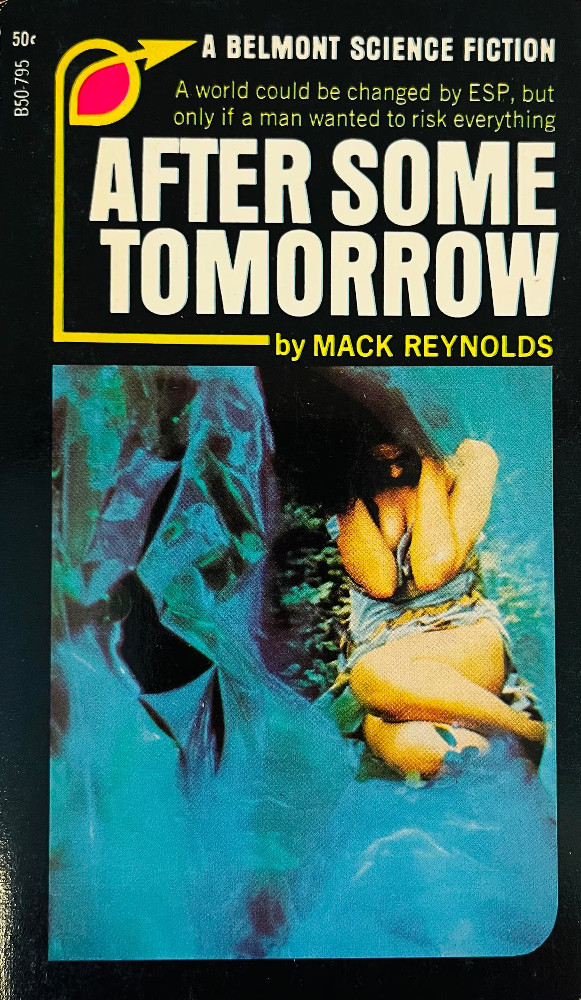
Are you a Mack Reynolds fan? Then you'll like this book because it is the essence of Mack Reynolds from top to bottom, incorporating all of his strengths and few of his weaknesses.
In brief: The time is the late 20th Century. The setting is the United American States. If you've read Reynolds' Joe Mauser stories, then you know this future Earth is both a utopia and a dead end. The Cold War still simmers, but the People's Capitalism of the UAS and the Communism of the SovWorld are now two sides of the same coin: automation has put most people out of work, and wealth is concentrated with the elite while everyone else is stuck in fairly rigid castes, most living on the dole and watching telly while tranked up on free drugs. Common Europe and the few neutral countries aren't much better off.
Mick Grant and Anna Enesco are scholarship students, awarded their grant from the Joshua Porsenna endowment for a very specific reason–both seem to have the talent of precognition. The plot thickens when the mysterious and (in most places) illegal Monad Foundation also offers both of them exorbitant grants. All the Monads want is for the two to study socio-economic texts, from Anarchism to Zapata, Communism to Technocracy. Throw in the involvement of both military and government intelligence, and you've got the makings for quite an exciting time! But Reynolds manages to throw in yet another twist before finishing this slim novel, revealing the identity of the mysterious Porsenna.
The pacing for this book is excellent. Not a single chapter concluded that didn't tempt me to move on to the next. The setting is fascinating and also disturbingly plausible, and the motivation of the Monadians makes a depressing amount of sense. Of course, this being Reynolds, the book is peppered with historical essays with subjects like the anarchist Bakunin and the Greek colony of Cumae. Somehow, Reynolds makes it work. Maybe it's because the subject material was germane or simply well-presented, but it never turned me off.
The only real disappointment I had was the Anna Enesco's evolution into a caricature. She is at first played for frigid but independent. Over time, she falls for Mick, but there's never really a pay-off scene that sells the attraction. It's just accepted as having happened. By the end, her dialogue is stilted in the extreme.
I think dialogue has always been Reynolds' weak point. The man has traveled the world and has a broad knowledge of things. He knows how to plot, how to pace, how to build a world, but his characters are simply pieces in that world (though Mick isn't badly drawn, if a bit dense).
Unfortunately, this book came out November of last year; I only got to it now. As a result, though I'm giving it four stars, it's too late to make last year's Galactic Stars. Still, I recommend it.

by Blue Cathey-Thiele
Ace Double H-59
The Time Mercenaries, by Phillip E. High
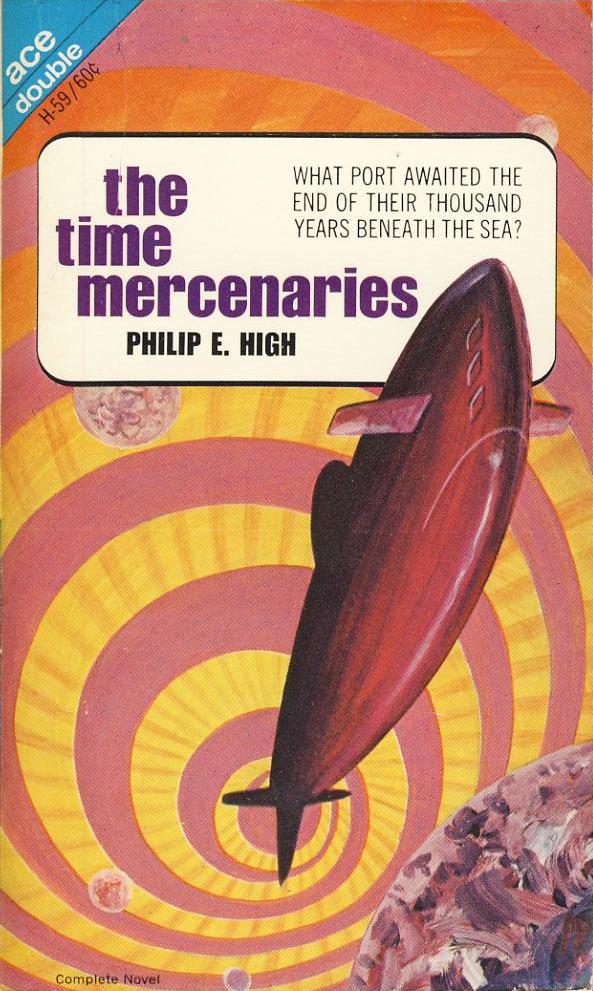
Captain Randall and his crew have been preserved inside their submarine for over a thousand years. When an alien species refuses all compromise and sets out to destroy human life to make space for their own ever-growing population, these men are revived. They find humanity has genetically suppressed aggression and can't fight back, even in self defense against the Nerne.
Randall is physically outmatched, but future technology defends against future threats, and using old tricks and weapons they are able to sneak attacks under the radar. He is assigned eager robots who join his crew. After one of his men accidentally discovers how to unlock aggression – in one of my least favorite segments, when he hits a woman who insults him after they have sex, after which they… fall in love immediately and decide to get married – Randall recruits more humans. An unanticipated ally comes in the Revain, who have been fending off the Nerne for centuries. These alien allies bring their advanced tech, ships, and pills that work just as well to unlock aggression.
In the end, what ends the war isn't overwhelming force or superior firepower – it's social disruption. Using the computing of the robots, and the methods of the past, they undermine the highest ranking Nerne and cause the population to question the waves of existing lives sacrificed for potential future life.
The Nerne aren't alone in upheaval. Humans have also had a shift. With aggression, passion was also suppressed. Visible violence was removed, but other insidious forms remained – the crew had been used as a sort of nearly-alive wax museum for years before revival as a grim reminder, the government overruled the people's say, sent political opponents to become aggressive "deviants", and tasked robots – who were capable of feeling – with fighting and "dying" for them. Randall is disgusted by modern humanity's hands-off approach that still puts others in the line of fire and at the callous disregard of life by the Nerne. He doesn't delight in war, but recognizes when violence is called for to stop more death.
High makes clever use of the change in times and thinking. They didn't swoop in and do more damage, they were simply unexpected. How did they make humans violent again? Punching them in the face! It sounds absurd, and it is! But in a society without aggression, no one would be able to take that first swing.
While the whole book is set in a theater of war it explores what it means to be peaceable and how that can, and can't be achieved. It also makes a compelling case for contraceptives, and against eugenics.
4 1/2 stars
Anthropol, by Louis Trimble
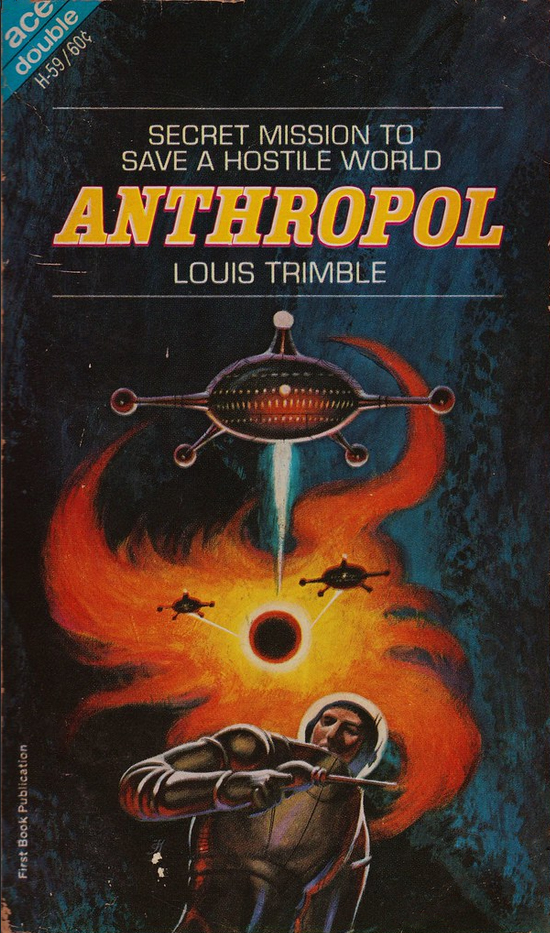
Anthropol member Vernay is sent on an undercover assignment to a planet that his organization recently made and lost contact with when their scout team was killed. He is conditioned to fit in with the people, once from Earth, who live on Ujvila. It's a society strictly ordered by sex and rank, with men as subservient. He joins up with resistance fighters, helping facilitate change through the planet's own people and systems. Vernay must work around the Galactic Military (Gal-Mil) who have the same end goal but use force. He is captured and tortured, then meets the political and spiritual leader, the Kalauz. She confirms the existence of an alien presence that Anthropol had previously thought only metaphorical. These small aliens operated replicated human-forms but are no longer a threat as planetary defense scans for them.
Lori, the Captain of the Gal-Mil presence, is captured and sent to a "joy-labor camp" where prisoners rarely live past two years. Vernay volunteers himself to the camp to break her out or die trying. They escape with rebel help.
Vernay puts together odd hints he has noticed through his time on the planet, and brings it to a head when he calls to see Rosid, a resistance leader. Many of the rebels are, in fact, Ngign aliens posing as Ujvilans. Trisk, an Ujvilan rebel and cousin to the Kalauz, is horrified to discover that her people's minds were destroyed to create duplicates for the aliens. Vernay finds the one weak spot on the constructed body, the Ngignians dying in moments without a means to filter the atmosphere. They reach the Kalauz, but she too has been replaced. Trisk destroys her body, and takes over as Kalauz, starting social reform.
The epilogue calls Vernay and Lori back to the planet, as Trisk had spent four years improving the world, only to regress it to the original state, spurring new revolutionaries.
Anthropol went from a political revolution plot to an alien takeover in the last moments of the book. Although clues lead up to it, the plot turned so many times in the final chapters that it seemed there was another book's worth of material that hadn't been fully incorporated. Since so much time was spent exploring alternative methods, having the ultimate defeat come by physically attacking and killing the aliens instead of using Anthropol tactics was a let down. Also, Trimble recreated a female/male style system among the women, with feminine, "pretty" women as leaders, and masculine women given the roles usually assigned to men. As a commentary on the treatment of the sexes, it fell short.
3 stars

![[May 18, 1968] Four Out of Six Ain't Bad (May 1968 Galactoscope)](https://galacticjourney.org/wp-content/uploads/2023/05/680518books-672x372.jpg)

![[April 16, 1968] Tripods and Others (April 1968 Galactoscope)](https://galacticjourney.org/wp-content/uploads/2023/04/680416covers-672x372.jpg)

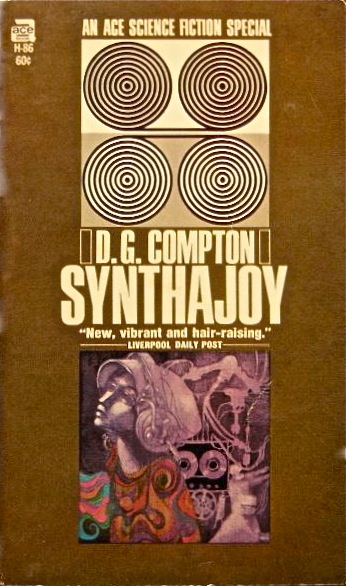
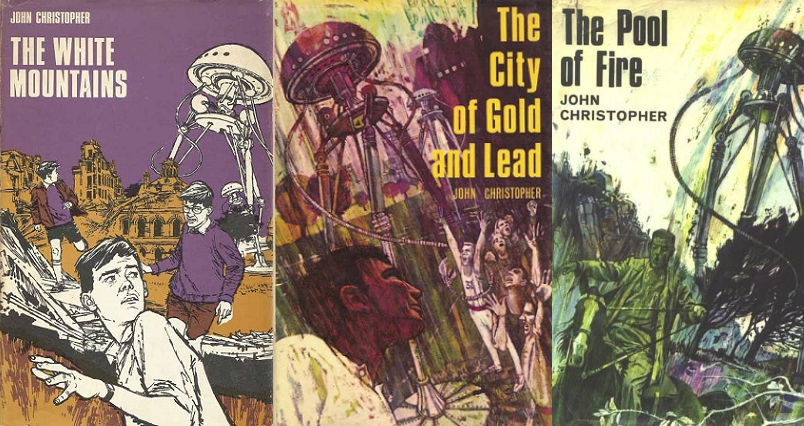


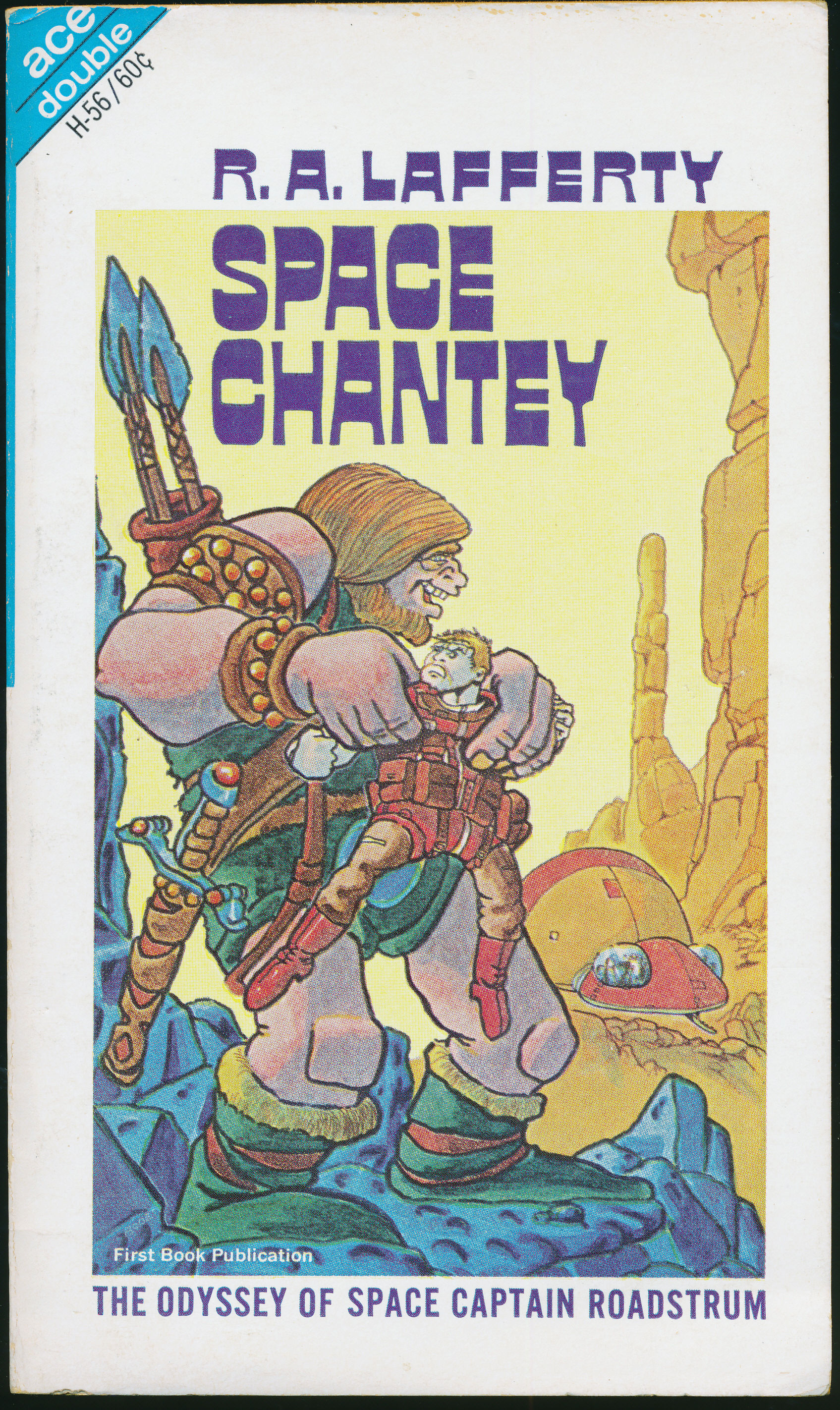
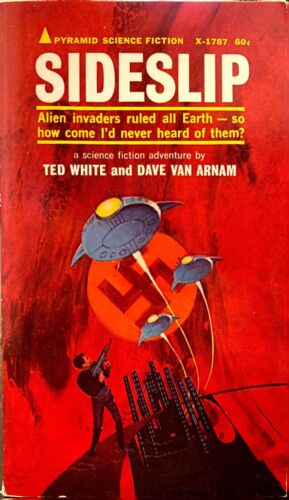
![[March 18, 1968] What Defines Humanity? (<i>Do Androids Dream of Electric Sheep?</i>)](https://galacticjourney.org/wp-content/uploads/2023/03/680318cover-scale-2_00x-506x372.jpg)




![[March 16, 1968] In Distant Lands (March Galactoscope)](https://galacticjourney.org/wp-content/uploads/2023/03/680316covers-672x372.jpg)






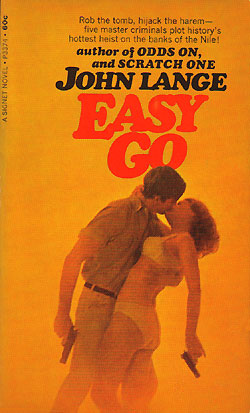










![[February 14, 1968] Triple John (February 1968 Galactoscope)](https://galacticjourney.org/wp-content/uploads/2023/02/680214titles-672x372.jpg)




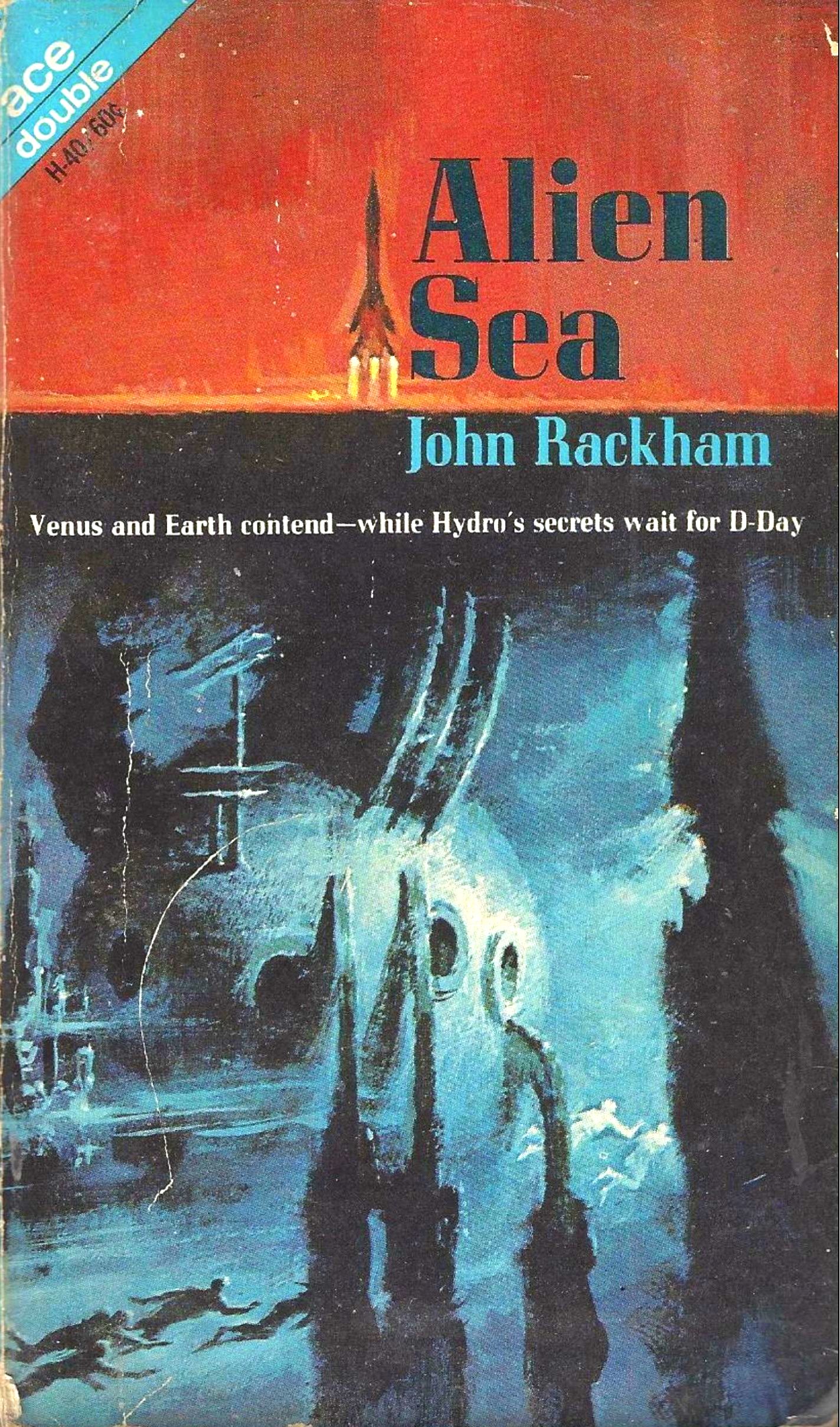

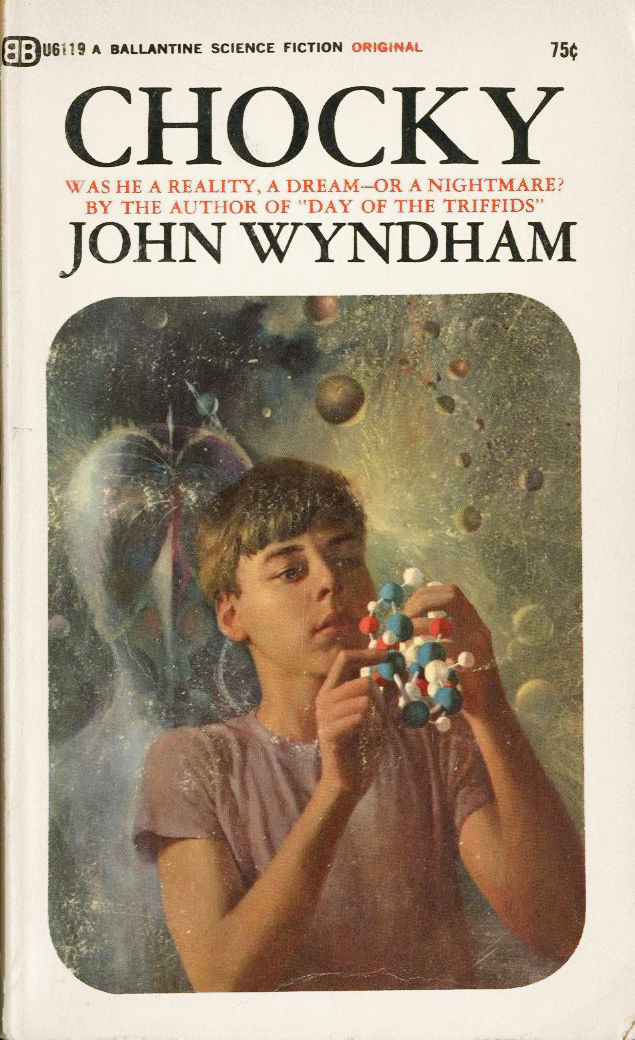
![[February 6, 1968] The Most Dangerous Dame (<i>Confessions of a Psycho Cat</i>) and From the Land of Hype (Ellison's <i>From the Land of fear</i>)](https://galacticjourney.org/wp-content/uploads/2023/02/680206covers-672x372.jpg)












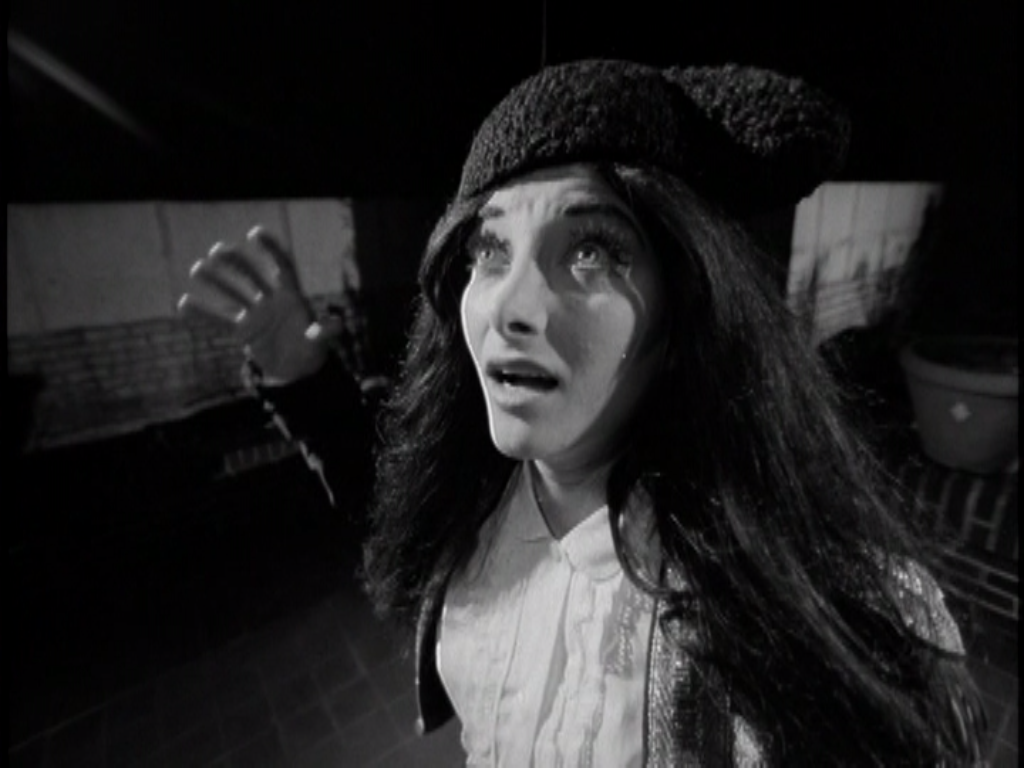




![[January 20, 1968] Alyx and Company (January 1968 Galactoscope)](https://galacticjourney.org/wp-content/uploads/2023/01/680120covers-672x372.jpg)
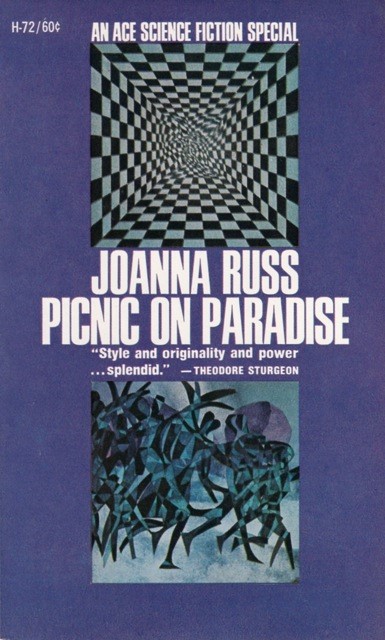



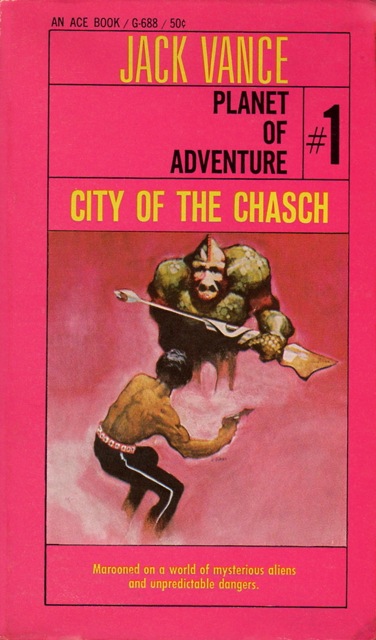






















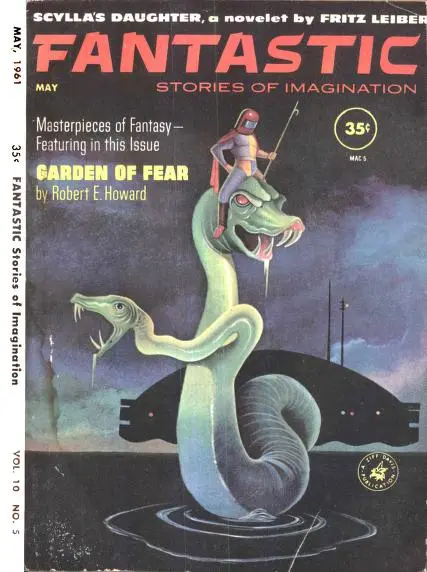

![[January 14, 1968] As Is (February 1968 <i>Amazing</i>)](https://galacticjourney.org/wp-content/uploads/2023/01/amz-0268-cover-492x372.png)







![[January 10, 1968] Saving the Best For Last (<i>Dangerous Visions</i>, Part Three)](https://galacticjourney.org/wp-content/uploads/2022/10/1967_Dangerous-Visions-hc-672x372.jpg)

![[December 16, 1967] Long Distance Travel (December 1967 Galactoscope)](https://galacticjourney.org/wp-content/uploads/2022/12/671216covers-672x372.jpg)
